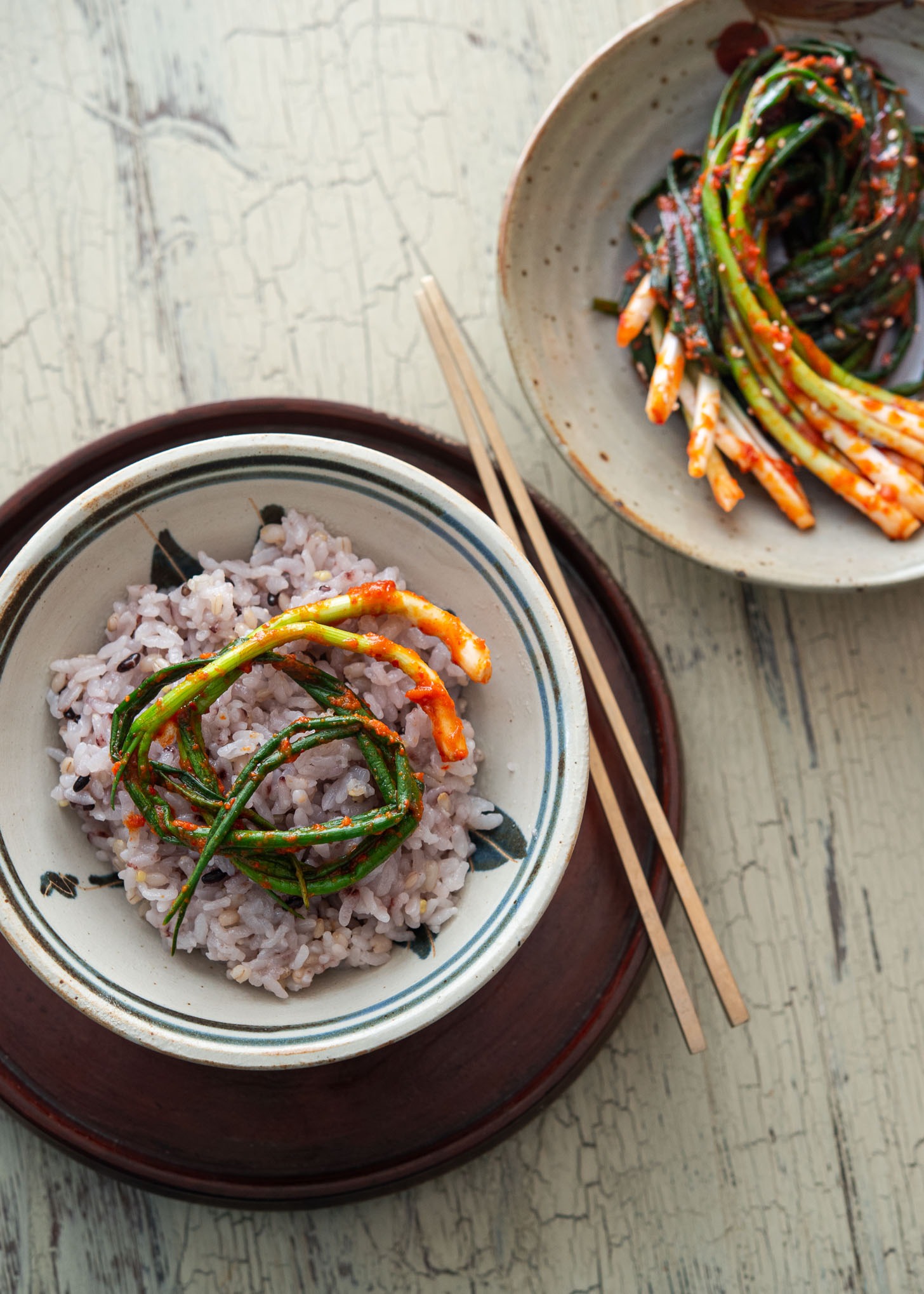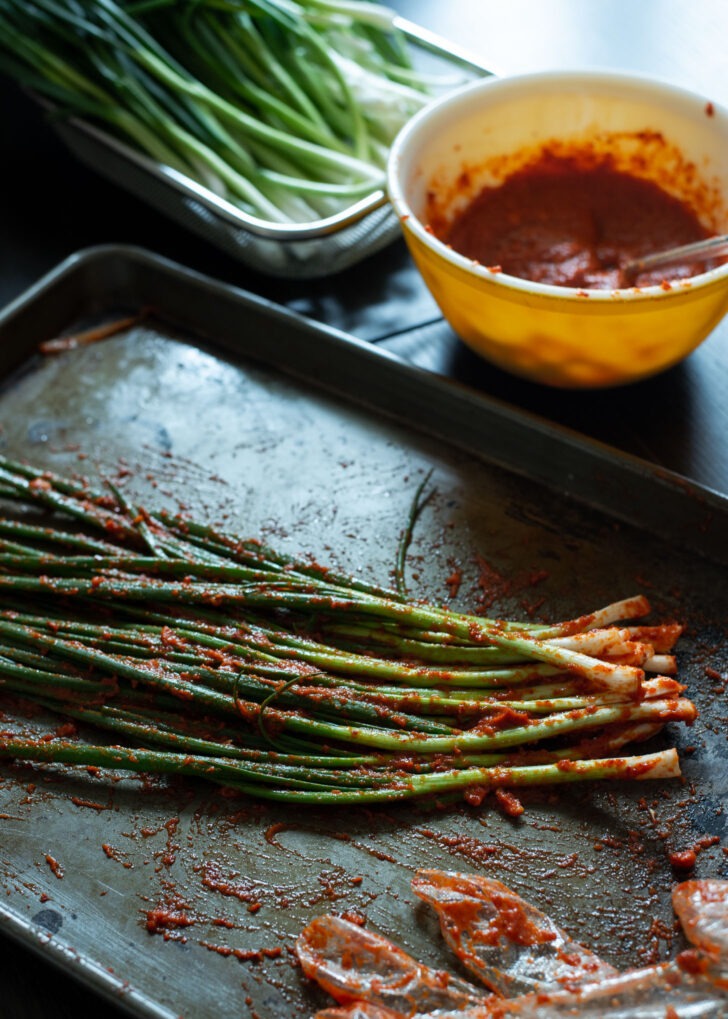Pa Kimchi (Green Onion Kimchi)
Pa kimchi, also known as green onion kimchi, is a delicious and refreshing variation of the traditional Korean kimchi. Made with fresh green onions, Korean chili flakes, and fish sauce, this quick kimchi is ready in 20 minutes and makes a perfect as a side dish or condiment to any Korean meal.

If you’re a fan of kimchi and looking for something new to try this spring and summer, why not give green onion kimchi, Pa kimchi in Korean, a go? Also known as scallion kimchi, this variation of the classic Korean dish can be made using fresh spring onions and a few key seasonings.
And don’t let the fancy name fool you, because pa kimchi is a quick and easy dish to make with just a few simple ingredients. In just 20 minutes, you’ll have a refreshing side dish that’s sure to impress. Plus, it’s adaptable for vegan diets!

But green onion kimchi isn’t the only veggie-based kimchi worth trying during the warmer months. Cucumber kimchi, perilla leaf kimchi (kkaennip kimchi) and chive kimchi (buchu kimchi) are a few examples of the delicious and refreshing kimchi options you can experiment with.
Pa kimchi has become a popular side dish to serve with Jjajangmyeon (Korean black bean noodles) in recent years. The zesty and tangy flavors of the green onion kimchi perfectly complement the rich and savory taste of the noodles, making it a fantastic and delicious pairing that you should try if you’re curious


Tips for Selecting Green Onion for Pa Kimchi
To make pa kimchi, you should use fresh green onions or scallions. In Korea, they are called Jjokpa (쪽파) and they are often sold in bundles in Korean and other Asian markets.
Look for slim green onions with a bright color for pa kimchi. Both the white and green parts can be used in the kimchi, but make sure to remove any roots or tough outer layers. And don’t forget to give them a good wash and pat dry before using them in your recipe!

Got yourself a large bundle of fresh green onions and looking for some recipe inspiration? Here are a few dishes that can help you make good use of them:
- Pajeon (Korean Scallion Pancake): A savory pancake made with scallions and seafood (optional). It’s a popular street food in Korea and can be served as a snack or appetizer.
- Korean green onion salad: A refreshing side dish salad made with thinly sliced green onions, red chili flakes, garlic, vinegar, and sugar. It’s a great accompaniment to Korean samgyupsal BBQ.
- Quick Sesame Soba noodles: A simple and quick noodle dish made with soba noodles, green onions, sesame seeds, soy sauce, and a touch of sugar. It’s a great option for a light lunch or dinner.
- Simple Egg Fried Rice: A classic fried rice dish made with eggs, rice, green onions, and soy sauce. It’s a versatile dish that can be customized with additional vegetables or protein.
Try your hand at one of these recipes and get ready to savor the delicious and versatile flavor of fresh green onions!
Ingredient list
- Green onion: Also known as scallions or spring onions. They provide a fresh and zesty flavor to the dish.
- Onion: Adds a mild and sweet flavor to the aromatic puree that forms the base of the kimchi.
- Apple (or Asian pear): Provides natural sweetness and helps to tenderize the green onions. Asian pear is often used in traditional recipes, but apple is a common substitute.
- Ginger: Adds a warm and slightly spicy flavor to the aromatic puree.
- Korean fish sauce: Either anchovy sauce (myulchi acjeot) or another type of Korean fish sauce can be used. It adds a savory and umami depth to the dish.
- Korean plum extract (optional): Provides a subtle fruitiness to the kimchi and can be added for extra flavor complexity.
- Korean chili flakes (gochugaru): Gives the kimchi its signature red color and spicy kick. It’s a staple ingredient in Korean cuisine and adds a bold flavor to many dishes.
How to Make Pa Kimchi


Step 1. Prepare the aromatics
In a mini blender, combine onion, apple (or Asian pear), ginger, fish sauce, and Korean plum extract (if using). Blend until smooth.
Vegan adaptation tip: If you want to enjoy as a vegan kimchi, replace fish sauce with Korean soup soy sauce.


Step 2. Add chili flakes (gochugaru)
Pour the aromatic paste into a bowl and add the Korean chili flakes (gochugaru). Let the mixture sit for 5 minutes to allow the gochugaru to rehydrate and intensify in color, forming a paste-like consistency.


Step 3. Apply the seasoning paste
Take a small portion of the green onion and apply the seasoning paste, spreading it evenly around the onion. Repeat with the rest of the green onions, then store the pa kimchi in an airtight container.
Expert Tip: When making pa kimchi, it’s efficient to use a shallow baking sheet.
Tips for storing and serving
To properly store pa kimchi, let it sit at room temperature for one day before placing it in the refrigerator. The flavor will continue to develop as it ferments in the fridge over the course of 2-3 weeks, but you can consume it immediately.
When serving, use a knife or a pair of kitchen scissors to cut the pa kimchi into your desired size for easy serving.

Dishes to pair with Pa Kimchi
- Jjajangmyeon: Korean-Chinese dish with wheat noodles, black bean sauce, diced pork or seafood, and vegetables.
- Jjamppong: Spicy Korean soup with seafood, noodles, and vegetables.
- Bulgogi: Classic Korean dish with thin slices of marinated beef, grilled or pan-fried until tender.
- LA Galbi: Korean-style short rib dish, marinated and grilled or broiled.
- Beef Seaweed Soup: Savory Korean soup with beef, seaweed, and various vegetables.

Pa Kimchi (Green Onion Kimchi)
Ingredients
- 1 1/2 lb (750 g) green onion, trimmed
- 1/2 small onion, diced
- 1/2 small sweet apple or 1/4 Asian pear, seeded and diced
- 1 inch (2.5 cm) fresh ginger, peeled and chopped
- 6 tbsp (90 ml) Korean anchovy sauce
- 2 tbsp (30 ml) Korean plum extract (maeshil cheong) , optional
- 2/3 cup (160 ml) Korean chili flakes (gochugaru)
Instructions
- In a mini blender, combine onion, apple (or Asian pear), ginger, anchovy sauce, and Korean plum extract (if using). Blend until smooth to create a paste.
- Pour the aromatic paste into a bowl and add the Korean chili flakes (gochugaru). Let the mixture sit for 5 minutes to allow the gochugaru to rehydrate and intensify in color, forming a paste-like consistency.
- Take a small portion of the green onion and apply the seasoning paste, spreading it evenly around the onion. Repeat with the rest of the green onions, then store the pa kimchi in an airtight container.Expert Tip: When making pa kimchi, it's efficient to use a shallow baking sheet.
- Storing and Serving: let it sit at room temperature for one day before placing it in the refrigerator. While it can be consumed immediately, the flavor will continue to develop as it ferments in the fridge over the course of two to three weeks. When serving, use a knife or a pair of kitchen scissors to cut the pa kimchi into your desired size for easy serving.
Notes
- Selecting green onion: look for slim green onions with a bright color when selecting your ingredients for pa kimchi. Both the white and green parts can be used in the kimchi, but make sure to remove any roots or tough outer layers. And don’t forget to give them a good wash and pat dry before using them in your recipe!
- Vegan adaptation tip: If you want to enjoy as a vegan kimchi, replace fish sauce with Korean soup soy sauce.


The method is missing the part about when to add anchovy sauce. I just realized there was none until after I put the green onions in an airtight container.
You’re right, I indeed missed that in the instructions. My apologies for the oversight.
The method calls for cooked white rice but I don’t see it in the ingredients list. How much cooked white rice should I use? And what kind of rice?
You don’t need the cooked white rice in this updated recipe, although you can add a little bit, about a tablespoon, if you would like. It is totally optional.
Hi there! Do you– or does anyone else here– have any instructions on how I’d need to adjust the recipe if I were bottling/preserving it?? (as in mason jars?).
When I make kimchi, I usually buy about 4-5 lbs. worth of veggies and put it in jars that I give to my friends/family (because it can be a few days/weeks before I see them to pass it off).
Practically every recipe I’ve seen recommends tying the stalks together, and letting it ferment at room temp…
Question: When I make this I let the onions ferment at room temperature for several weeks, then store it in the fridge pretty much forever. Is this just me being lazy/extreme or is this sort of thing done in Korea? Thanks!
several weeks sounds way too long. Green onion doesn’t need to ferment in the room temperature that long. Just a couple of days and then store in the fridge until they are eaten all.
what red chile flakes do you recommend? would Wang’s be a good choice?
That should be fine.
Great kimchi, now when a recipe calls for scallions, I use this to give the dish extra kick.
Can you recommend a vegan alternative to the anchovy sauce?
Try Korean soy sauce for soup. You can find more information about this sauce in my “Korean Pantry” tab on the navigation bar above.
What a great idea, Holly! I never though about making green onion kimchi. It must be very yummy! I will make it soon. Should be a great summer dish with congee
By “Anchovy Sauce”, do you mean fish sauce? This looks great and I must try it!
Yes, you can use fish sauce.
Wow! Your kimchi looks so fresh and delicious! Perfect for this time of year.
haha this look so delicious!! I have still to try my hands at making homemade kimchi and i think this is perfect! One question though Can I chop the green onions in smaller pieces and what’s rice glue?? Any substitutions?
Yes, you can chop the green onion into smaller pieces. Rice glue is boiled rice flour in water. You can substitute with cooked plain white rice. Just puree 2 tablespoons of cooked rice with 1/2 cup of water until very smooth.
Holly, one of my faves!!! beautiful!!!
Yum! I never tried making kimchi from green onion, what a great idea! PS I love how you wrapped the green onions in a knot!
Never had green onion kimchi. Love the idea, though. Thanks for the breath warning. 🙂